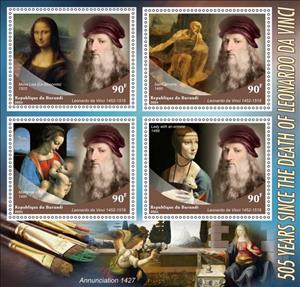Mini Sheet: Leonardo da Vinci 505th Death Anniversary (Burundi 2024)
Leonardo da Vinci 505th Death Anniversary (Burundi 2024)
01 January (Burundi ) within release Famous People (2024) goes into circulation Mini Sheet Leonardo da Vinci 505th Death Anniversary face value 4*90 Burundian franc
| Mini Sheet Leonardo da Vinci 505th Death Anniversary in catalogues | |
|---|---|
| Colnect codes: | Col: BI 2024-28 |
Mini Sheet is square format.
This item is produced by the counterfeit producer located in Moscow, Russia and distributed by criminal counterfeit stamp dealers located in Eastern Europe mainly in Kazakhstan and Estonia. Avoid anyone selling this!Also in the issue Famous People (2024):
- Stamp - Albert Schweitzer face value 90;
- Mini Sheet - Albert Schweitzer face value 4*90;
- Stamp - Albert Schweitzer face value 90;
- Mini Sheet - Albert Schweitzer face value 4*90;
- Stamp - Albert Schweitzer face value 90;
- Mini Sheet - Albert Schweitzer face value 4*90;
- Stamp - Albert Schweitzer face value 90;
- Mini Sheet - Albert Schweitzer face value 4*90;
- Stamp - Albert Schweitzer face value 90;
- Mini Sheet - Albert Schweitzer face value 4*90;
- Mini Sheet - Charles Darwin face value 4*90;
- Mini Sheet - Charles Darwin face value 2*90;
- Mini Sheet - Franklin Roosevelt face value 8*90;
- Mini Sheet - Leonardo da Vinci 505th Death Anniversary face value 4*90;
- Mini Sheet - Leonardo da Vinci 505th Death Anniversary face value 2*90;
- Mini Sheet - Mahatma Gandhi face value 4*90;
- Mini Sheet - Mahatma Gandhi face value 2*90;
- Mini Sheet - Winston Churchill wrongly titled Franklin Roosevelt face value 4*90;
- Mini Sheet - Winston Churchill wrongly titled Franklin Roosevelt face value 4,500;
|
Data entry completed
50%
|
|
|---|---|
| Mini Sheet Leonardo da Vinci 505th Death Anniversary in digits | |
| Country: | Burundi |
| Date: | 2024-01-01 |
| Emission: | Illegal |
| Format: | Mini Sheet |
| Face Value: | 4*90 Burundian franc |
Mini Sheet Leonardo da Vinci 505th Death Anniversary it reflects the thematic directions:
An anniversary is the date on which an event took place or an institution was founded in a previous year, and may also refer to the commemoration or celebration of that event. For example, the first event is the initial occurrence or, if planned, the inaugural of the event. One year later would be the first anniversary of that event. The word was first used for Catholic feasts to commemorate saints. Most countries celebrate national anniversaries, typically called national days. These could be the date of independence of the nation or the adoption of a new constitution or form of government. The important dates in a sitting monarch's reign may also be commemorated, an event often referred to as a "Jubilee".
Famous People refers to the fame and public attention accorded by the mass media to individuals or groups or, occasionally, animals, but is usually applied to the persons or groups of people (celebrity couples, families, etc.) themselves who receive such a status of fame and attention. Celebrity status is often associated with wealth (commonly referred to as fame and fortune), while fame often provides opportunities to make money.
An invention is a unique or novel device, method, composition, idea, or process. An invention may be an improvement upon a machine, product, or process for increasing efficiency or lowering cost. It may also be an entirely new concept. If an idea is unique enough either as a stand-alone invention or as a significant improvement over the work of others, it can be patented. A patent, if granted, gives the inventor a proprietary interest in the patent over a specific period of time, which can be licensed for financial gain.
Painting is a visual art, which is characterized by the practice of applying paint, pigment, color or other medium to a solid surface The medium is commonly applied to the base with a brush, but other implements, such as knives, sponges, and airbrushes, may be used. One who produces paintings is called a painter.
Painting is the practice of applying paint, pigment, color or other medium to a solid surface (support base). The medium is commonly applied to the base with a brush, but other implements, such as knives, sponges, and airbrushes, can be used. Painting is a mode of creative expression, and the forms are numerous. Drawing, gesture (as in gestural painting), composition, narration (as in narrative art), or abstraction (as in abstract art), among other aesthetic modes, may serve to manifest the expressive and conceptual intention of the practitioner. Paintings can be naturalistic and representational (as in a still life or landscape painting), photographic, abstract, narrative, symbolistic (as in Symbolist art), emotive (as in Expressionism), or political in nature (as in Artivism). A portion of the history of painting in both Eastern and Western art is dominated by spiritual motifs and ideas. Examples of this kind of painting range from artwork depicting mythological figures on pottery, to Biblical scenes rendered on the interior walls and ceiling of the Sistine Chapel, to scenes from the life of Buddha or other images of Eastern religious origin. In art, the term painting describes both the act and the result of the action. The support for paintings includes such surfaces as walls, paper, canvas, wood, glass, lacquer, clay, leaf, copper and concrete, and the painting may incorporate multiple other materials including sand, clay, paper, plaster, gold leaf, as well as objects. The term painting is also used outside of art as a common trade among craftsmen and builders.




